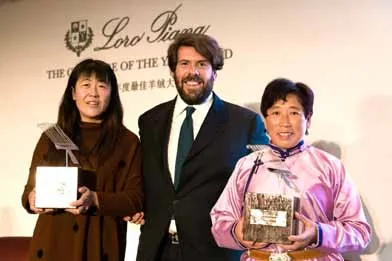“The Loro Piana Cashmere of the Year Award” explores the sustainability of cashmere, herdsmen,and the land

The educational commitment of the Loro Piana Method extends to many areas of China
“The Loro Piana Cashmere of the Year Award” was held on October 23rd, 2017 in Beijing. Numerous herdsmen throughout Inner Mongolia and other Chinese areas, including Loro Piana’s trusted suppliers, who compete in this contest based on the objective criteria of fineness, length and performance. This year the two breeder couples - Mr. Batunashun and Mrs.Burenqiqige, and Mr. Yaolong Liu and Mrs. Haiyan Lu – who received the 2017 prize produced a lot of greasy cashmere from adult goats of 250kg(102kg net cleaned) with a fibre diameter of 13.74 microns and a length of 29.34 mm (official measurement by the CNR, the Italian National Research Council).
Loro Piana operates in the high-end luxury goods sector and has made uncompromising quality its mission, offering the most discerning clients clothing, accessories and gifts which have been made in Italy from the finest raw materials in the world.
Fabio d’Angelantonio, CEO of Loro Piana, declares: “Our initial assumption at the start of the project is proving us right: actively supporting the shepherds’ efforts, the production process and skill of quality cashmere in full respect of nature is for Loro Piana an ethical responsibility. The best cashmere in the world is at the core of some of the most precious Loro Piana fabrics and this excellence allows us to tirelessly perfect the performance of raw materials, and thus the beauty and quality of our final products.”
The Loro Piana Method, a modern system of selective breeding designed to optimize the quality of cashmere produced in the Alashan region launched in 2009,has transcended local boundaries and now extends to the whole of Inner Mongolia (Alashan Right Banner, Arbas,Etuokeqi, Chifeng) and Xinjiang. In ethical terms, this is a source of great satisfaction for the company which,as one of the key operators in the cashmere industry since 1960, does not restrict itself to merely securing the best fibre in the world in order to guarantee the utmost quality of its products to its consumers.

Fabio d’Angelantonio presents awards to the breeders
It was in fact this strong connection that led to the launch of the zootechnical pilot project based on the principles of bioeconomy that initiated the approach known as the Loro Piana Method. It was developed in collaboration with the Jilin Agricultural University in China, the Academy of Science of Inner Mongolia, the Academy of Science of Xinjiang and the University of Camerino in Italy and the ENEA (the Italian National Agency for New Technologies, Energy and Sustainable Economic Development). It is thanks to the excellent results achieved that Loro Piana obtained the authorization to sign direct agreements with local government entities, thus becoming the first foreign company permitted to conduct research on Chinese territory.
The expanding of this method shows the strengthening of the synergies with technical-scientific Chinese entities (Academy of Sciences Inner Mongolia), it promotes training courses on the genetic improvement in various regions of Inner Mongolia and of surrounding provinces (the first course is scheduled for the end of October in Etuokeqi), and supports the international PhD thesis on Chinese cashmere.
Following the impressive results of this study, and ever conscious of the delicate relationship between animals,areas and local populations, Loro Piana has embarked on a new venture alongside and supporting the herdsmen who, since 2015,have been the recipients of “The Loro Piana Cashmere of the Year Award”.
The research project and its extension to much larger production areas aims to improve the quality of cashmere by a sustainable use of territory and by helping to create a greater social balance in the long term. By choosing the best goats (average fibre diameter of less than 14 microns and yield over 500 grams) for selective breeding and optimizing the collection of cleaner and more homogeneous fibre, fineness has been enhanced while maintaining an elevated amount of down per animal. The obtained results show a highly impressive improvement in the fineness of the fibre by 1 micron over a period of 5 years. Consequently, raising a smaller number of goats allowed the herdsmen to obtain high levels of annual production, which in turn is reflected in optimized standards of living, as well as a restored balance between animals and habitat.

- China Textile的其它文章
- Technology is the best footnote to change life
- Intertextile Shanghai Apparel Fabrics: In-depth leading to create extraordinary
- A new decade to power glory of fashion knitting
- New materials,New momentum &New trends
- To explore the great courses of Beijing Fashion Industry 2017 Beijing Fashion Summit
- Snow Lotus performed first show to highlight cultural self-confidence of domestic brands

